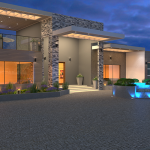The Essential Guide to Understanding As-Built Drawings in Modern Design
Introduction to As-Built Drawings
As-built drawings are basically a map of a finished project. Think of them as the ultimate guide to what was actually built, versus what was supposed to be built. These drawings include all the changes that were made during the construction process, making them the final word on the project’s reality. Whether it’s a building, a road, or any other structure, as-built drawings document every detail after construction is complete.
They’re super important for several reasons. First, they help anyone working on the building in the future understand exactly how it’s put together. This is crucial for maintenance, renovations, or expansions. Second, if there’s ever a legal question about the construction or a dispute about what was agreed upon, as-built drawings are the go-to document to set things straight. Lastly, they serve as a valuable resource for creating replicas or similar projects in other locations.
Creating as-built drawings is the job of the project team after the project is finished. They go through, compare the original plans with what’s actually there, and note down every little change, no matter how small. This includes everything from the position of electrical outlets to structural changes.
In summary, as-built drawings are the final blueprint of a completed project. They are the difference between planning and reality, and they play a critical role in understanding, maintaining, and replicating buildings and structures. Without them, we’d be pretty much guessing how things were built, and nobody wants to take chances with that.
The Importance of As-Built Drawings in Modern Design
In the modern design world, as-built drawings are your project’s final draft. They show the building exactly as it was built, changes and all. Think of them as the reality check to the original plan. These drawings are crucial for several reasons. First off, they ensure that all construction complies with the approved design and the relevant codes. If there’s a dispute or a question about the building, as-built drawings are the go-to for clarity. They’re also vital for future renovations or expansions. Knowing exactly how a building was constructed makes any new changes safer and more efficient. Plus, they help facility managers with maintenance and operations, showing where every pipe and wire lives. Without as-built drawings, managing a building can be a guessing game. So, whether you’re dealing with construction, maintenance, or upgrades, these documents are your blueprint to the truth of your building’s anatomy.
Differences Between As-Built Drawings and Other Design Documents
As-built drawings are not the same as your typical design documents or blueprints. Let’s get this straight: design documents lay out the plan, the dream – what’s supposed to happen. They’re all about the vision, showing every detail of the project as it’s imagined before any real work starts. On the other hand, as-built drawings come into play at the end of the game. They show what actually happened, the reality on the ground. After all the construction dust settles, these documents capture every pipe, wall, and wire exactly as they are built, including any changes that happened along the way. In simple terms, think of design documents as the project’s “before” picture and as-built drawings as the “after” shot. One is about potential, while the other is about reality. So, when you hear someone mention as-built drawings, remember they’re talking about the final word on what got built, not what was supposed to be built.
Key Elements and Details Found in As-Built Drawings
In as-built drawings, details are king. They show not only what was planned but what actually got built—the real deal. Imagine them as the ultimate blueprint, updated to reflect any changes made during construction. These documents include everything from the exact location of walls, doors, and windows to the nitty-gritty like electrical outlets, plumbing fixtures, and even the types of materials used. Here’s a breakdown of what you’ll typically find:
- Measurements and Dimensions: Forget about guesstimates. As-built drawings give you precise numbers for every part of a building, down to the inch.
- Material Specifications: Whether it’s the type of wood used for the flooring or the brand of the electrical switches, this info is all there.
- Location Details: Not just “a window here”, but exactly where, how big, and what kind.
- Changes: Perhaps the most crucial part. If the original plan called for a door to be 3 feet wide and it ended up 3.5 feet, this is documented.
- Technical Data: This could include info on the building’s HVAC systems, electrical circuits, or plumbing lines.
Why does this matter? For anyone looking to renovate, repair, or even just understand a building’s structure, as-built drawings are a treasure trove of information. They ensure that everyone involved knows the building inside out, making future work smoother and safer.
The Process of Creating As-Built Drawings
As-built drawings are the final piece of the document puzzle after a construction project is done. They’re a bit like a story of the building but in blueprints. Here’s how it’s done: First, designers or architects sketch out the project plans. These are the dreams, the “what we want” phase. Then, construction kicks off. Things on the ground might change because maybe what was planned isn’t possible, or better ideas come along. As these changes happen, they’re noted down, sometimes on the original drawings or in separate notes. After the project wraps up, it’s time to take those changes and bake them into the final as-built drawings. These drawings show the building exactly as it stands, warts and all. No pretending it’s something it’s not. It’s about being real, showing every pipe, wire, and wall as they really are. This process isn’t just about updating drawings, though. It’s a deep dive to make sure every little change is documented, making as-built drawings the truth of the project. These drawings are crucial for anyone who has to work on the building in the future. Whether it’s fixing a leak or adding a new wing, having accurate as-built drawings means you’re not flying blind. You know exactly what you’re dealing with.
The Role of Technology in Producing As-Built Drawings Today
Technology has completely reshaped how as-built drawings are created and used. Gone are the days where everything was sketched by hand on large drawing sheets. Today, software like CAD (Computer-Aided Design) and BIM (Building Information Modeling) are the real game changers. These tools allow architects and engineers to draw with incredible precision, making modifications a breeze. With CAD, creating detailed two-dimensional drawings is straightforward. However, BIM takes it a step further by enabling three-dimensional visualizations that include not just the design but also information about materials and costs. This tech also makes collaboration easier. Now, teams across different locations can work together on the same project in real time, sharing updates and changes instantly. This efficiency not only saves time but also significantly reduces errors, making the as-built drawings more accurate and reliable for any future reference or construction tasks. In short, technology in producing as-built drawings today means better accuracy, less time, and more collaboration.
Understanding the Legal and Regulatory Significance of As-Built Drawings
As-built drawings aren’t just another pile of paperwork. They’re the backbone of any construction project, ensuring everyone’s on the same page long after the last nail has been hammered in. Think of these drawings as a final report card, showing what was actually built compared to the original plan. Why does this matter? Let’s break it down.
First, as-built drawings are crucial for legal reasons. If any disputes arise, these documents are your go-to evidence. They detail every modification, helping to resolve conflicts about what was agreed upon versus what was delivered. In essence, they’re the truth tellers of construction.
Secondly, regulatory bodies love as-built drawings. Why? Because safety and compliance aren’t just nice-to-haves; they’re must-haves. These drawings ensure that the structure meets all building codes and regulations. If inspectors come knocking, as-built drawings prove your project’s integrity.
In short, skipping on as-built drawings might save you a minute today but could cost you a fortune tomorrow. They’re not just drawings; they’re your project’s diary, legal shield, and proof of compliance. Keep them close.
How As-Built Drawings Contribute to Efficient Project Management
As-built drawings play a crucial role in managing a project efficiently. These drawings are the final set of plans, showing the building exactly as it was built, including any changes made during the construction process. Here’s why they’re key for project management: First, they provide a precise record of the building’s layout and specifications. This clarity reduces confusion and errors, making coordination between teams smoother. If there’s ever a question about how a part of the building was constructed or what materials were used, referring to the as-built drawings gives you the answers you need. Second, they’re invaluable for future renovations or maintenance. Knowing the exact state of the building as it stands helps in planning modifications or repairs, saving time and money by avoiding surprises. Lastly, as-built drawings ensure compliance with regulations. They serve as proof that the construction meets the original design specifications and adheres to all relevant codes and standards. In essence, having detailed as-built drawings is akin to having a manual for the building. They streamline project management, making it more effective and less prone to costly mistakes.
Common Challenges in Working with As-Built Drawings and How to Overcome Them
Working with as-built drawings comes with its pack of challenges. First off, accuracy is often a headache. Why? These drawings are supposed to show the building as it was actually built, not how it was planned to be. But sometimes, details get missed or not updated. Imagine finding out a wall is not where it’s supposed to be. Frustrating, right? To dodge this, always double-check measurements and updates with the actual building.
Then, there’s the access issue. Getting your hands on these drawings can be like looking for a needle in a haystack, especially for older buildings. A solid workaround is reaching out to building departments or the original construction team. It takes effort but beats working in the dark.
Another pain point is the quality of drawings. Some as-builts look like they were drawn by a tired kid at the end of the day. To overcome this, using digital versions can be a lifesaver. They’re clearer and easier to adjust. Plus, digital tools help bring those ancient drawings into the modern age, making collaboration and updates a breeze.
Finally, inconsistency can drive anyone up the wall. Different teams might use different standards or formats, turning a simple task into a decoding mission. Standardizing how as-built information is documented and shared across all teams involved can prevent a lot of headaches.
Bottom line, while working with as-built drawings might test your patience, there are ways around these challenges. Stay vigilant, embrace digital solutions, and push for standardization. That’s how you turn potential obstacles into mere stepping stones.
Conclusion: The Future of As-Built Drawings in Architecture and Engineering
As we wrap up our journey through the world of as-built drawings, it’s clear these documents are more than just detailed records. They are invaluable tools that bridge the gap between concept and reality in architecture and engineering. As technology advances, the future of as-built drawings looks promising. With digitalization and 3D modeling becoming the norm, these drawings are not only getting more accurate but also more accessible. Tools like Building Information Modelling (BIM) are transforming as-built drawings from static documents into dynamic databases of information that can be used throughout a building’s life cycle, from construction to renovation, and even demolition. This evolution means better project outcomes, more efficient maintenance, and smarter planning decisions. As-built drawings are no longer just about documenting what has been built; they’re about paving the way for future innovations in the design and construction industry. As we move forward, the only constant will be change, and as-built drawings will undoubtedly continue to play a critical role in capturing that change, ensuring that the built environment not only meets but exceeds our present and future needs.












